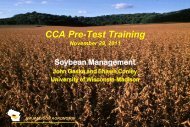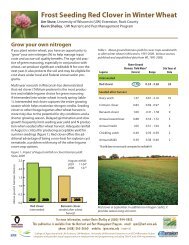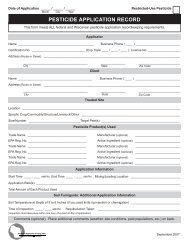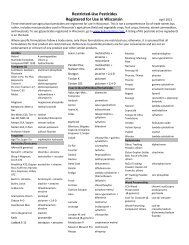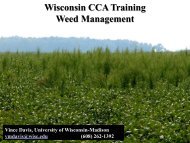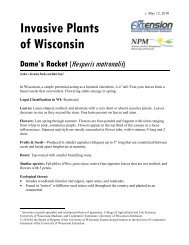IPM Crop Scouting Weed Guide - PDF
IPM Crop Scouting Weed Guide - PDF
IPM Crop Scouting Weed Guide - PDF
Create successful ePaper yourself
Turn your PDF publications into a flip-book with our unique Google optimized e-Paper software.
PIGWEED FAMILY<br />
Waterhemp<br />
Amaranthus tuberculatus<br />
Cotyledon: linear; egg-shaped<br />
Leaves: nick in tip of first leaves; long-petioled; 3 to<br />
6 in. long;somewhat shiny<br />
Stems: smooth, often with colored stripes<br />
Infloresence: small greenish flowers, male and female<br />
flowers on separate plants<br />
Other: several species of waterhemp in the region;<br />
resistant biotypes<br />
PURSLANE FAMILY<br />
Purslane (71)<br />
Portulaca oleracea<br />
Cotyledon: linear or oblong, smooth<br />
Leaves: fleshy, rounded, opposite<br />
Stems: fleshy, prostrate, reddish, branched<br />
Flowers: 5 yellow petals; small; numerous<br />
Seeds: small, flattened, oval, glossy black<br />
Other: plants can establish from stem pieces<br />
MUSTARD FAMILY<br />
Wild mustard (89)<br />
Brassica kaber<br />
Cotyledon: heart or kidney-shaped; smooth<br />
Leaves (stems): few bristly hairs<br />
Lower leaves: large, triangular and lobed (not to midrib)<br />
Upper leaves: reduced in size; no petioles<br />
Flowers: 4 bright yellow petals<br />
Seed pods: “beak” of seed capsule 1/3 length of whole<br />
capsule; open to release round seeds<br />
Waterhemp seedling<br />
Waterhemp young plant<br />
Purslane seeds<br />
Waterhemp infloresence<br />
Purslane flower Purslane plant<br />
Wild mustard seedpod<br />
Wild mustard stem<br />
Wild mustard stem<br />
Wild mustard flowers




